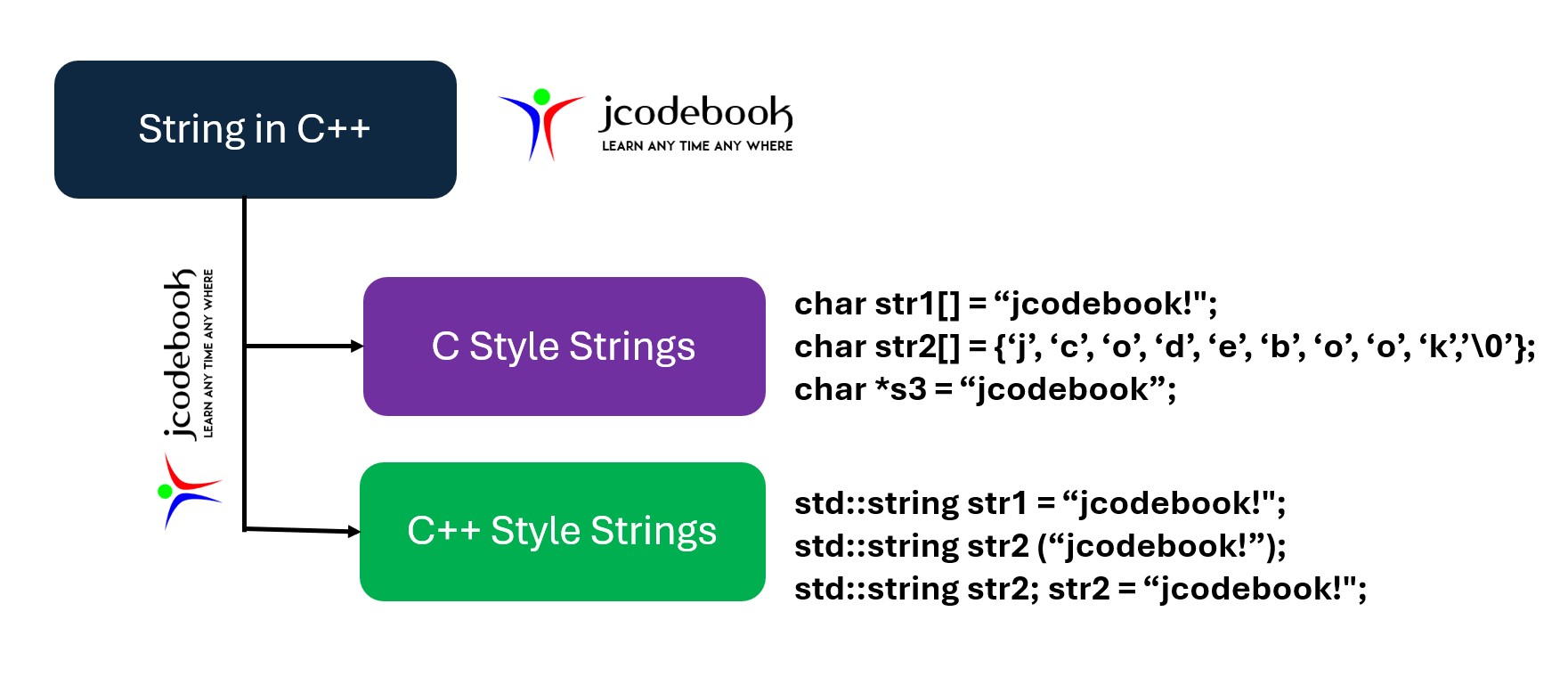In this lesson, you will learn
std::string class
In C++, strings can be created in two main ways: using C-style strings (character arrays) and using the C++ std::string class. Let’s go through both methods with examples.

In C++, C-style strings (character arrays) can be created in various ways. Here are the different methods:
You can directly initialize a character array with a string literal. The compiler automatically adds the null terminator ('\0').
#include<iostream>
int main() {
// Direct initialization with a string literal
char str[] = "Hello, World!";
std::cout << "C-style string: " << str << std::endl;
return 0;
}
str is automatically sized to include the null terminator ('\0')."Hello, World!" is stored in the array str.You can manually assign each character to specific positions in the array and ensure you include the null terminator at the end.
#include<iostream>
int main() {
// Character-by-character initialization
char str[6]; // Array size must be at least 6 (5 characters + 1 null terminator)
str[0] = 'H';
str[1] = 'e';
str[2] = 'l';
str[3] = 'l';
str[4] = 'o';
str[5] = '\0'; // Null terminator
std::cout << "C-style string: " << str << std::endl;
return 0;
}
'\0') to indicate the end of the string.You can partially initialize a character array and leave the rest uninitialized. However, you must include the null terminator manually.
#include<iostream>
int main() {
// Partial initialization
char str[10] = {'H', 'e', 'l', 'l', 'o', '\0'};
std::cout << "C-style string: " << str << std::endl;
return 0;
}
You can create an empty character array and then copy a string into it using the strcpy function from the C library.
#include<iostream>
#include<cstring> // Include the C string library
int main() {
// Creating an empty character array
char str[20];
// Copying a string using strcpy
strcpy(str, "Hello, World!");
std::cout << "C-style string: " << str << std::endl;
return 0;
}
strcpy is used to copy the string "Hello, World!" into the character array str.str should be large enough to hold the copied string and the null terminator.
C++ provides a std::string class in the Standard Library, which simplifies string manipulation by automatically handling memory management and providing various functions for string operations.
#include<iostream>
#include<string>
using namespace std;
int main() {
// Creating a C++ string
string str1 = "Hello, World!";
// You can also declare an empty string and assign a value later
string str2;
str2 = "Hello";
// Concatenating strings
string str3 = str2 + ", C++!";
//Creates a copy of another string
string str4 = str3;
//Creates a string with multiple repetitions of a character
string str5(5, 'A'); // "AAAAA"
// Printing C++ strings
cout << "C++ string 1: " << str1 <<endl;
cout << "C++ string 2: " << str2 <<endl;
cout << "Concatenated C++ string: " << str3 <<endl;
cout << "Copy String: " << str4 <<endl;
cout << "Repetitions of a character: " << str5 <<endl;
return 0;
}
C++ string 1: Hello, World!
C++ string 2: Hello
Concatenated C++ string: Hello, C++!
Copy String: Hello, C++!
Repetitions of a character: AAAAA
Here’s a summary table that outlines the key differences between C-style strings and C++-style strings.
| Aspect | C-Style String | C++-Style String (std::string) |
|---|---|---|
| Definition | Array of characters ending with a null character ('\0'). |
Class from the C++ Standard Library. |
| Memory Management | Manually managed, requiring careful handling of buffer sizes. | Automatically managed by the std::string class. |
| Safety | Prone to errors like buffer overflows and memory leaks. | Safer, with automatic memory management and bounds checking. |
| Functionality | Limited; requires using functions from the C library (strlen, strcpy, etc.). |
Rich set of built-in member functions (e.g., .length(), .substr(), .find()). |
| Ease of Use | More complex, requires manual handling of memory and null terminators. | Easier to use with high-level operations provided by the class. |
| Mutability | Mutable, but changes need careful management of buffer sizes. | Mutable and automatically manages resizing when needed. |
| Performance | Generally faster in simple cases due to lower overhead but riskier. | Slightly slower due to additional safety and flexibility, but often negligible in most cases. |
| Initialization | Can be directly initialized with a string literal or manually character by character. | Can be initialized with literals, another std::string, or various constructors. |
| Size Handling | Size must be explicitly managed by the programmer. | Size is automatically managed, with easy access to the length via .length() or .size(). |
noiceeeeee
Very Very important.
great concepts
You must be logged in to submit a review.